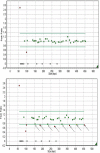Can we rely on the multiplex ligation-dependent probe amplification method (MLPA) for prenatal diagnosis?
- PMID: 24976821
- PMCID: PMC4071631
Can we rely on the multiplex ligation-dependent probe amplification method (MLPA) for prenatal diagnosis?
Abstract
Background: The major aneuploidies that are diagnosed prenatally involve the autosomal chromosomes 13, 18, and 21, as well as sex chromosomes, X and Y. Because multiplex ligation-dependent probe amplification (MLPA) is rapid and non-invasive, it has replaced traditional culture methods for the screening and diagnosis of common aneuploidies in some countries.
Objective: To evaluate the sensitivity and specificity of MLPA in a cross-sectional descriptive study for the detection of chromosomal aneuploidies in comparison to other methods.
Materials and methods: Genomic DNA was extracted from the peripheral blood samples of 10 normal controls and the amniotic fluid of 55 patients. Aneuploidies screening of chromosomes 13, 18, 21, X and Y were carried out using specific MLPA probe mixes (P095-A2). For comparison purposes, samples were also tested by Quantitative Fluorescent-PCR (QF-PCR) and routine chromosomal culture method.
Results: Using this specific MLPA technique and data-analyzing software (Genemarker v1.85), one case was diagnosed with 45, X (e.g. Monosomy X or Turner's Syndrome), and the remaining 54 cases revealed normal karyotypes. These results were concordant with routine chromosomal culture and QF-PCR findings.
Conclusion: The experiment demonstrates that MLPA can provide a rapid and accurate clinical method for prenatal identification of common chromosomal aneuploidies with 100% sensitivity and 100% specificity.
Keywords: Common aneuploidies; MLPA; Prenatal screening.
Figures


Similar articles
-
[Effectiveness of multiplex ligation dependent probe amplification (MLPA) in prenatal diagnosis of common aneuploidies].Ginekol Pol. 2013 Aug;84(8):682-90. doi: 10.17772/gp/1624. Ginekol Pol. 2013. PMID: 24191501 Polish.
-
Rapid screening for chromosomal aneuploidies using array-MLPA.BMC Med Genet. 2011 May 17;12:68. doi: 10.1186/1471-2350-12-68. BMC Med Genet. 2011. PMID: 21575262 Free PMC article.
-
Performance of MLPA as a screening method for aneuploidy in uncultured amniocytes.J Turk Ger Gynecol Assoc. 2010 Dec 1;11(4):199-203. doi: 10.5152/jtgga.2010.37. eCollection 2010. J Turk Ger Gynecol Assoc. 2010. PMID: 24591936 Free PMC article.
-
Use of a DNA method, QF-PCR, in the prenatal diagnosis of fetal aneuploidies.J Obstet Gynaecol Can. 2011 Sep;33(9):955-960. doi: 10.1016/S1701-2163(16)35022-8. J Obstet Gynaecol Can. 2011. PMID: 21923994 Review.
-
Rapid methods for targeted prenatal diagnosis of common chromosome aneuploidies.Semin Fetal Neonatal Med. 2011 Apr;16(2):81-7. doi: 10.1016/j.siny.2011.01.003. Semin Fetal Neonatal Med. 2011. PMID: 21316319 Review.
Cited by
-
Detection of Aneuploidies in Products of Conception and Neonatal Deaths in Iranian Patients Using the Multiplex Ligation-Dependent Probe Amplification (MLPA).Avicenna J Med Biotechnol. 2021 Jul-Sep;13(3):143-148. doi: 10.18502/ajmb.v13i3.6363. Avicenna J Med Biotechnol. 2021. PMID: 34484644 Free PMC article.
-
22q11 Copy Number Variations in a Brazilian Cohort of Children with Congenital Heart Disorders.Mol Syndromol. 2023 Feb;14(1):1-10. doi: 10.1159/000525247. Epub 2022 Jul 4. Mol Syndromol. 2023. PMID: 36777701 Free PMC article.
References
-
- Yusuf RZ, Naeem R. Cytogenetic abnormalities in products of conception: a relationship revisited. Am J Reprod Immunol. 2004;52:88–96. - PubMed
-
- Hochstenbach R, Meijer J, van de Brug J, Vossebeld-Hoff I, Jansen R, van der Luijt RB, et al. Rapid detection of chromosomal aneuploidies in uncultured amniocytes by multiplex ligation-dependent probe amplification (MLPA) Prenat Diagn. 2005;25:1032–1039. - PubMed
-
- Nicolaides KH. Screening for chromosomal defects. Ultrasound Obstet Gynecol. 2003;21:313–321. - PubMed
-
- Boormans EM, Birnie E, Oepkes D, Galjaard RJ, Schuring-Blom GH, van Lith JM, et al. Comparison of multiplex ligation-dependent probe amplification and karyotyping in prenatal diagnosis. Obstet Gynecol. 2010;115:297–303. - PubMed
LinkOut - more resources
Full Text Sources
